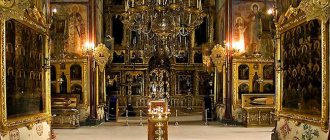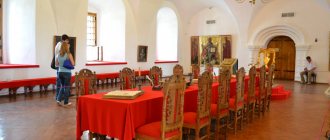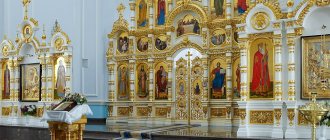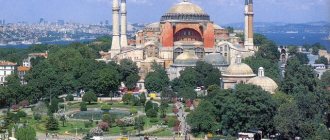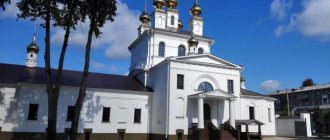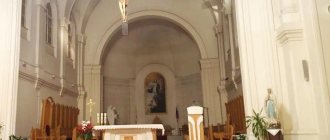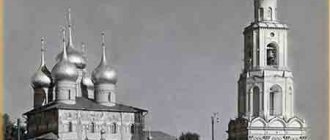“Like a single stone” - this is how the Assumption Cathedral of the Moscow Kremlin, currently the oldest building in the Russian capital, has long been characterized in chronicles. Beginning its history in 1326, the temple survived many fires, looting by Napoleon's troops, artillery fire from the Red Guards and even an earthquake, but still managed to withstand the storm of historical events. And the monolithic architecture of the temple by the Italian architect Aristotle Fioravanti acquired symbolic meaning, turning into a metaphor for the resilience of the Russian people and the Orthodox faith.
In addition to many revered icons, the Assumption Cathedral contains such relics as, for example, the Nail of the Lord and the staff of St. Peter, Metropolitan of Kyiv and All Rus', who initiated the construction of the cathedral. However, even a person far from religion will be extremely interested in visiting this temple.
Located on Cathedral Square, in the very heart of the Moscow Kremlin, the Assumption Cathedral is also firmly entrenched in the history of the country. Since 1498, coronations began to be held there. In 1613, Michael, the first ruler of the Romanov family, was crowned king here, and in 1896, the last Russian Emperor Nicholas II received the crown. In addition, for more than 3 centuries the cathedral was the resting place of the heads of the Russian Church. Without losing its cult significance, the Assumption Cathedral is an eloquent monument to how closely the secular and religious authorities in Rus' have always stood to each other.
All hotels near the Assumption Cathedral in Moscow
Moscow becomes the capital - the beginning of the history of the Assumption Cathedral
After the residence of the Russian Metropolitan was moved to Moscow in 1326, the Grand Duke of Moscow Ivan Kalita, on the advice of Bishop Peter, decided to begin laying the foundation of a new stone cathedral. The fact is that the church could no longer satisfy the ambitions of both ecclesiastical and secular authorities that were emerging at that time. For the main capital's temple, the wooden church was too small, and for the residence of the metropolitan, it was not solid enough. In general, August 1326 was the year of the foundation of the Assumption Cathedral
. It is difficult to say 100% which temple served as the prototype for the construction of the new one, however, the versions of authoritative historians agree on this issue to St. George’s Cathedral, located in Yuryev-Polsky.
And already in 1327 the first stone temple was erected in Moscow. Its location is the highest point on the Kremlin hill, which is why the cathedral received the interesting historical name “the cathedral on Makovitsa”.
View of the eastern façade of the cathedral
Icons
The main iconostasis is located opposite the western gate. The ensemble, consisting of 69 icons, was created in 1653 by several artists from Kostroma and Yaroslavl in just 10 months. Structured in 5 rows. The upper, forefathers' row includes not only a full-length image of the forefathers with scrolls, but also an icon of the Holy Trinity. The prophetic level consists of 17 images. The festive row is filled with icons depicting the main events of the New Testament. The Deesis series includes images of the apostles, an icon with the prayer of the saints at the Last Judgment, and an icon of the “Savior Almighty.” In the bottom row are “The Golden Robe of Savior” and “The Ardent Eye of Savior.”
The most ancient icons are located near the southern wall, including “Metropolitan Peter with his Life.” It is believed that it was written by Dionysius, a follower of Andrei Rublev. The iconostasis near the northern wall contains icons by the servants of the Solovetsky Monastery. They were brought in 1923. The most famous images are “It is Worthy to Eat” and “The Mother of God of Bogolyubsk, with the Lives of Zosima and Savvaty of Solovetsky.”
Destruction of the “Cathedral on Makovitsa”
Unfortunately, no buildings last forever, and if they are not seriously taken care of, sooner or later they will fall into disrepair. Although the cause of the severe dilapidation of the cathedral, built during the time of Ivan Kalita, is rather the constant occurrence of fires. Yes, after a century and a half, the temple was so shabby that the question of a total reconstruction or a new building arose by itself. After weighing all the pros and cons (severely crumbling stone, and the dilapidation of some structures - the vaults had to be supported with logs), after the fire that occurred again in 1470, it was decided to dismantle the old cathedral and build a new one.
Interior
The first painting of the temple was created by a team of painters, headed by Dionysius. However, during the great fire the frescoes were badly damaged. Artists from all over the country were invited to re-decorate the interior. 150 artists worked on painting the walls. They were led by Sidor Pospeev, Boris and Ivan Paisein. The work was completed in 1642-1644.
Picturesque compositions consist of interconnected subjects:
- Under the dome is the vault of heaven
- Upper tier – paintings based on the Gospel
- Second tier – biography of the Virgin Mary
- Lower tier – 7 Ecumenical Councils
There are 249 compositions in total. The cathedral houses a huge collection of Orthodox icons. Among the glorified ones are the Vladimir Mother of God, Our Lady Hodegetria, the Assumption, the Bright Eye of the Savior, St. George, the Trinity. The total height of the iconostasis is over 16 m. It has 5 tiers.
In front of the iconostasis:
- On the left side is the royal seat
- On the right side is the place of the patriarch
Another decoration of the temple is the chandelier, cast in silver to commemorate the victory over the Napoleonic army. The huge candelabra weighs 328 kg.
About the history of the Assumption Cathedral in the 15th century
Construction of the new cathedral began in 1472. There is much more information about this cathedral - in particular, even the names of the master architects are known: a certain Krivtsov and Myshkin. The Assumption Cathedral in Vladimir was taken as a model for the construction of a new temple.
. The construction of the updated “version” of the stone temple was approached thoroughly.
Cathedral domes
Construction took so long that, in order not to interrupt the church service, a temporary wooden church was even built on the site of the altar of the old temple. This church is notable for the fact that it was here that the wedding of Tsar Ivan 3 with Sophia Palaeologus, a princess from Byzantium, took place. This memorable event took place in November 1472. Further - more: the newly built cathedral, which had almost reached the final phase of construction, collapsed.
The reason was very simple - the imperfection of construction technologies of that time. Which is understandable, since Russia at that time was just moving from wooden to stone construction. The solution that Russian master architects prepared as a binding material turned out to be fragile and liquid. Ivan 3 first called Pskov architects to carry out the reconstruction, but they looked, shook their heads, smacked their lips and refused. Then Ivan 3 decided to act completely unconventionally and intended to invite the builders of the new temple directly from Italy!
View of the cathedral from Cathedral Square
Before the corresponding order had time to mature in the royal office, Ivan 3 had completely decided on his choice - he became Ridolfo Aristotle Fioravanti, more of an engineer than an architect, who was involved in the low tide and raising of the bells to the belfries. In addition, Fioravanti specialized in laying water canals, building and restoring bridges. Fiorovanti was famous for his engineering work in both Hungary and Italy.
Once again, the construction of the new Assumption Cathedral was completed by 1479, 2 years after that the temple was covered with church paintings. Russian architects, looking at the foreigner's overseas construction techniques, were surprised by the new technologies. “Theirs” were especially distrustful of the vaults, the thickness of which was no more than one brick. We thought that the ceiling would leak during rains, but this did not happen. For the first time in Russian stone buildings, metal rods were used, and the method of delivering them to the right places was extremely unusual - on blocks with wheels.
View of the cathedral from Ivanovskaya Square
But the most important innovation lay not even in the combination of individual techniques and technologies, but in the internal configuration of the cathedral - it essentially had a single space in which several pillars were used as supports. There were also no chapels, which had never happened before in the architectural industry of Rus'.
Architecture
The creation of Aristotle Fioravanti harmoniously combines different architectural styles:
- Romanesque
- Byzantine
- Gothic
- Russian
Small stone blocks were used for construction. Due to this, the building has the appearance of a monolithic structure. The facade is divided into equal parts. Narrow window loopholes stand out on the surface of the walls. Along the entire perimeter of the structure stretches an arcature-columnar belt, consisting of decorative small arches resting on columns. The interior space is spacious and bright. The effect of openness is achieved through the use of round pillars supporting the dome and the creation of additional arches behind the iconostasis. In addition, innovations were tested during the construction of the building:
- Metal fasteners inside walls
- Single-brick cruciform vaults
The top of the church is covered with domes. Their layout is slightly shifted to the east. According to legend, the domes of the temple were first crowned with 8 terminal crosses.
New life of the Assumption Cathedral
The construction of a new temple under the leadership of an Italian master literally breathed new life into the cathedral. So, at the end of the 15th century, the grandson of Ivan 3, Dimitri, was crowned prince here, and already in 1547, the notorious Ivan the Terrible was crowned here.
. Moreover, the Assumption Cathedral in the Kremlin did not lose its national significance even after the capital of Russia was moved to St. Petersburg. Starting from Peter the Great, it has become a good tradition to crown all Russian emperors only in the Assumption Cathedral. The Europeans, represented by the French Napoleonic warriors, did not fail to desecrate and burn this temple in 1812, but during the war it was completely restored.
Entrance to the cathedral from Cathedral Square
Place for the wedding of kings
The first Russian monarch to receive his crown within the walls of the cathedral was Ivan IV, nicknamed the Terrible (1547). After the capital was moved from Moscow to St. Petersburg, the temple retained its status. The coronation ceremonies of Russian emperors continued to take place there. The high role of the temple in the state life of the country is evidenced by a specially made royal prayer place (1551). It was called the “Throne of Monomakh”. The walls forming the base of the seat have a painting about the gift of royal regalia by the Byzantine Emperor Constantine to Vladimir Monomakh, Prince of Kyiv.
At the foot of the throne, figures of fantastic animals are skillfully carved. The top, in the form of a tent, is supported by 4 pillars decorated with floral patterns. The wooden dome above the throne is decorated with bas-reliefs of strange birds. The chair was carved from walnut wood and painted by Novgorod craftsmen.
Assumption Cathedral in the 20th century...
At the turbulent beginning of the 20th century, which all of Russia was experiencing, the Assumption Cathedral made a fateful decision for the Russian Orthodox Church that the patriarchate in Rus' would be resumed again. The enthronement ceremony of Patriarch Tikhon was also held here. In the first years of Soviet power, the Assumption Cathedral was closed; the last church service was held in 1918 on Easter. It was this event that served as the subject for the painting of the famous Russian painter Pavel Korin “Departing Rus'”.
Why are the main churches of Rus' the Assumption?
Estimated reading time: 3 minutes.
On August 28, the Orthodox Church celebrates one of the main holidays - the Dormition of the Blessed Virgin Mary. It has been noted that in Rus' the most cathedrals and temples were consecrated in honor of the Assumption. Natalya Eduardovna Yufereva, candidate of philological sciences, senior lecturer at the Department of Cultural Studies at PSTGU, told us why exactly this event in the life of the Mother of God had such an impact on Russian church building .
Photo
— In my opinion, the explanation of this phenomenon can lie on two levels: in cultural tradition and in religious consciousness.
As for the cultural tradition, it was laid down from the very beginning of Christian church building in Rus'. The first stone church (the so-called Church of the Tithes) was dedicated to the Mother of God, although there is no information on which particular feast of the Mother of God, but the dedication itself is already indicative: it speaks of the special attitude of the Russian people to the intercession of the Mother of God. The main temple of Kievan Rus is called St. Sophia Cathedral (by analogy with the main Byzantine temple - Sophia of Constantinople). In the second largest city of Kievan Rus, Novgorod, St. Sophia Cathedral was also built in the 11th century. And here I like to ask students a tricky question: when are patronal feasts celebrated in these St. Sophia Cathedrals? I haven’t heard any answers! Over the course of several years, the only student accidentally answered correctly: “Maybe on some Mother of God holidays? Dormition or Nativity of the Virgin Mary..."
Note ed - In Orthodoxy, Sophia churches have always been dedicated to the Lord Jesus Christ - the Wisdom (Sophia) of God the Father. In Russia, after the 17th century, the Most Holy Theotokos began to be identified with Sophia. Thus, in Russian Orthodoxy a tradition developed when churches were dedicated to the Lord, but the main (throne) celebrations in them were celebrated on the feasts of the Mother of God.
St. Sophia Cathedral, Novgorod wikipedia. org/wiki
Indeed, patronal feasts in Russian St. Sophia cathedrals fall on the Mother of God - on the Nativity of the Virgin Mary in Kyiv and on Her Dormition in Novgorod. And this is very important for understanding the tradition of temple dedications in Rus'. After all, when Prince Andrei Bogolyubsky decided to move the capital from Kyiv to Vladimir-on-Klyazma, what did he do? First of all, he built the stone Assumption Cathedral as the future cathedral of Rus'. His dream of the capital city of Vladimir was not destined to come true, however, when one of the cities of the Vladimir-Suzdal principality (Moscow) became the Russian capital, it was the Assumption Cathedral that was erected as the main temple of Moscow Rus'. The continuity of dedication between the pre-Mongol “almost cathedral” cathedral and the cathedral of the united Russian state is obvious. In the new state there was no longer any division into principalities, and at the same time (in the cultural aspect) - into art schools (icon painting, architecture). Everyone and everything was now subordinate to Moscow; it set the political, cultural, and ideological tone. And so, in all cities and villages they began to build large cathedrals and small churches, dedicating them to the Dormition of the Mother of God - in the image and likeness of the Assumption Cathedral of the Moscow Kremlin. It seems to me that it is precisely in this desire for similarity (characteristic of medieval consciousness in general) that the cultural essence of the tradition of dedicating Russian churches to the Dormition of the Mother of God lies.
“Assumption Cathedral Vladimir 2011”, Photo by Glavkom NN - own work. /
As for the religious aspect of the phenomenon of such a wide distribution of Assumption churches in Rus', the answer, I think, is in the words of the troparion of the holiday itself: “...at the Assumption of the world you did not leave the world, O Mother of God.” The essence of the phenomenon I want to talk about is broader than purely Christian ideas. A person has an inherent consciousness that it is the deceased who can provide some special help in our earthly existence - supernatural, which the living could not provide. This is the Orthodox prayer to the saints and even sometimes to our deceased relatives, about whom we think that they have pleased God and now have prayerful boldness before Him... Perhaps this is where the Russian people have such a special attitude towards the feast of the Dormition of the Mother of God as a moment some kind of transfiguration of the Mother of God into the Intercessor of the Christian race. After all, only in Her Dormition does the Most Pure One receive a supernatural opportunity to help everyone and everyone on this earth who turns to Her in prayer.
Assumption Cathedral in Yaroslavl. Photo www. flickr. com, Alexxx Malev
Photo on the screensaver: www.fliсkr.com, thisisbossi
... even today
Today, the Assumption Cathedral, located on the territory of the Moscow Kremlin, has the status of a museum, but church services in connection with significant holidays of the Russian Orthodox Church are regularly held
. The Assumption Cathedral did not receive the status of the cathedral of Moscow, although this is understandable - more than half a century of age of the temple makes it somewhat unsuitable for this kind of load. However, in the series of monuments to Russian Orthodoxy and Russian architecture, the Assumption Cathedral in the Kremlin still occupies one of the main places.
Attraction rating
Rating 4.20 [10 vote(s)]
| ← KREMLIN CATHEDRALS | MOSCOW KREMLIN → |
Necropolis
Initially, it was planned to turn the church into a tomb for princes and Moscow metropolitans. The first burials date back to 1326. Subsequently, the role of the last refuge of princes and monarchs began to be played by another Kremlin cathedral - the Arkhangelsk Cathedral. And the main clergy of the country continued to be buried in the Church of the Assumption.
Within the walls of the cathedral there are 20 graves of metropolitans and patriarchs (14-17 centuries). They are located along the northern, western and southern walls of the building. Ancient burial sites are marked with small rectangular tombstones covered with metal sarcophagi. The patriarch's graves are covered with stone slabs on which epitaphs are carved. The miraculous relics are placed in wooden shrines decorated with metal plates.
How to get there
You can get to the cathedral by metro, bus or taxi:
| Nearest metro stations | Nearest bus stops | |||
| Name | Distance | Name | Distance | No. of routes |
| Alexander Garden | 910 m | Red Square | 750 m | m5, 158 |
| Big Stone Bridge | 950 m | m3, 255 (until 21.30) | ||
| Lenin's Library | 990 m | Metro station "Lenin Library" | 1.1 km | m2, m7, night n2 |
| Borovitskaya Square | 1.2 km | m27, m2, m3 | ||
| Manezhnaya Square | 1.2 km | m27,101, 144, 158, m5, 904, m10, m3, night: n1, n2, n11, n12 | ||
| Okhotny Ryad | 1 km | |||
A visit to the Kremlin, a walk through its vast territory of 27 hectares and a tour of the Kremlin cathedrals created by the most famous architects of their time will become unforgettable not only for guests of the capital, but also for Muscovites themselves.
But the heart of the Kremlin, after all, was and remains the Assumption Cathedral in Moscow - a place where you can feel so much spirituality, admiration and grandeur, perhaps, like nowhere else in Russia.
Author: Irina Zhuravka
mural painting
The best masters were hired to paint the first altar church. The oldest frescoes of the Moscow Kremlin are preserved on the altar barrier - images of ascetic monks, painted in 1481 by the artel of the great icon painter Dionysius. Altar compositions of the same time are also known - “The Seven Sleeping Youths of Ephesus”, “The Forty Martyrs of Sebaste”, “The Adoration of the Magi” and others. Then the Assumption Cathedral was painted in 1513-1515. In 1642-1643, this painting was knocked down with plaster, having previously removed the “translations”, and a team of 150 artists led by the royal isographers Ivan and Boris Paisein and Sidor Pospeev completed the existing mural.
The architecture and murals of the temple create an image of space, where the vaults symbolize the sky carried by the pillars of the cathedral. As a rule, images of martyrs are placed on the pillars, who support the Church with their lives and martyrdom, just as the pillars support the arch.
The painting of the Assumption Cathedral is distinguished by thoughtfulness and clarity of construction. The chapters contain various images of God, the upper parts of the walls are occupied by illustrations of the Gospel, their arrangement corresponds to the sequence of services throughout the year. The painting on the second tier from the top on the southern and northern walls tells the story of the miraculous birth of the Virgin Mary and Her childhood. The next row is occupied by illustrations of the Akathist in honor of the Mother of God. An interesting feature of the painting is the image of the seven Ecumenical Councils in the lower tiers of the walls. On the western wall of the temple there is traditionally a huge composition of the Last Judgment. Numerous figures of martyrs are painted on the round pillars.
